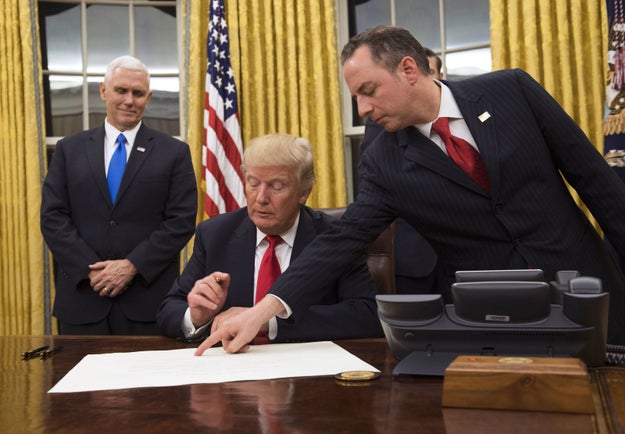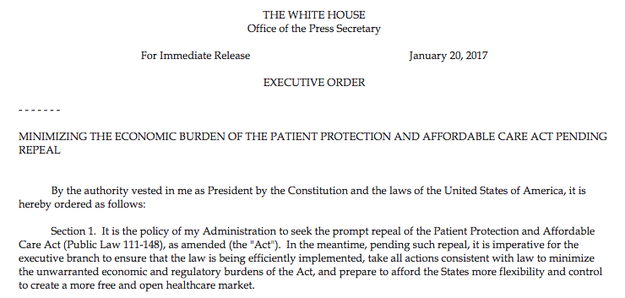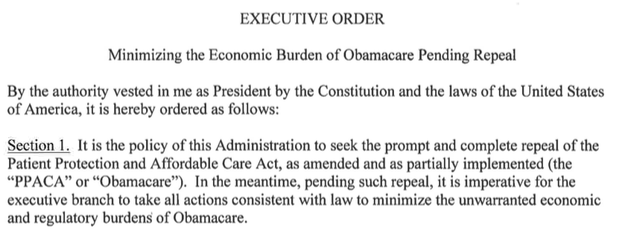[ad_1]

Pool / Getty Images
WASHINGTON — When White House press secretary Sean Spicer was asked Wednesday about a potential executive order for that would revive Bush-era detention and interrogation policies, he flatly denied any knowledge of its existence.
Saying it was “not a White House document,” Spicer added, “I have no idea where it came from.”
But the document is one of more than four dozen potential executive orders prepared for a would-be President Mitt Romney during his unsuccessful 2012 presidential campaign, BuzzFeed News has learned. Several of these documents appear to have been used by the Trump administration in the president’s first week in office.
Senior policy and legal advisers to Romney prepared the cache of memos and orders — a “menu of options” for “possible presidential directives” — in early September 2012, according to a source familiar with the project who shared them with BuzzFeed News, as well as metadata associated with the documents.
Former Utah Gov. Mike Leavitt, who led Romney’s transition planning efforts, told BuzzFeed News that the documents were part of extensive transition planning aimed at creating “executive order drafts prepared on various subjects related to commitments Romney made during the campaign.” He noted that they represented an early part of the planning process for the transition and that, given the fact that Romney lost and the transition planning never became an actual presidential transition, Romney himself never reviewed the proposals.
Among the cache was a series of the actions denoted as being “Day 1” priorities for a President Romney — although Leavitt cautioned against reading too much into those priority assertions given the early stage of planning they represented.
Among the “Day 1” actions, however, one was aimed at “Minimizing the Economic Burden of Obamacare Pending Repeal.”
Hours into Trump’s presidency, he signed his first executive order: “Minimizing the Economic Burden of the Patient Protection and Affordable Care Act Pending Repeal.”
The Trump order appears to be an updated, edited version of the Romney document. Notably, however, the Romney draft proposal called for “the prompt and complete repeal” of the ACA, whereas the Trump executive order simply calls for “the prompt repeal” of the ACA.
Trump executive order:

Romney transition planning proposal:

Two other actions taken by the new administration in Trump’s first week in office appear to be similarly updated versions of Romney transition planning proposals, as well as two others reportedly under consideration.
The carbon-copy orders cast a revealing spotlight on the extent to which Trump’s administration — a radical departure from Republican, and American, traditions in some respects — is leaning heavily on decades of conservative policymaking and expertise in others.
A rough count of Trump’s executive actions so far reveals three roughly even categories: some, like Trump’s “American Pipelines” memorandum, that trumpet “America First” nationalism; some rooted in the longtime priorities of the anti-immigration movement, of which Trump ally Kris Kobach is a key figure; and a final third borrowed from the Romney campaign, representing the mainstream small-government, pro-business Republicanism and war on terror policies of the Bush era. There are deep tensions between the third strain and the first two — Romney’s wing of the party, led now by House Speaker Paul Ryan, has championed immigration, for instance. The early split among the actions offers a glimpse at what may prove to be tensions — or may simply be a balancing act — inside Trump’s new administration.
Additionally, as Leavitt pointed out, it makes sense for the Trump administration to turn to the Romney plans given that he was the prior Republican nominee.
“I have no doubt that there were draft executive orders considered in our process that would have formed a great starting place for the Trump team,” Leavitt told BuzzFeed News. “Rather than starting from scratch, it would have made drafting more efficient.”
Noted issues with staffing up of the White House and agencies — and the delayed confirmation timeline for some of Trump’s key nominees — provide another reason why reliance on the previously prepared documents could be sensible.
Regardless of the reason, one of the most traditional of Republican nominees, Mitt Romney, is indirectly helping the most nontraditional president start his administration — despite not being invited to join it.
As Trump took office, the new White House chief of staff, Reince Priebus, issued a memorandum to the heads of executive departments and agencies declaring a “Regulatory Freeze Pending Review.” Had Romney taken office in 2013, according to the documents reviewed by BuzzFeed News, the new chief of staff potentially would have issued the same memo on day one — the draft is even anticipatorily dated Jan. 20, 2013.
While the document is similar to one signed by prior administrations, the memo issued by Priebus contains wording in the Romney memo that is missing from either or both of the memos from President George W. Bush and President Obama’s first chiefs of staff. For example, while Andrew Card referenced an exception for “critical health and safety functions” under Bush, Rahm Emanuel made the exception for “critical health, safety, environmental, financial, or national security functions.” Romney’s proposed order eliminated the “environmental” exception — as did the Priebus memo.
Similarly, while some elements of the Card memo are carried over to the Priebus memo, other portions are taken from the Emanuel memo — in exactly the same way as had been proposed for a Romney administration.
Even more clearly taken from the Romney proposed actions is the “hiring freeze” signed by Trump on Jan. 23.
Here’s Trump:
“By the authority vested in me as President by the Constitution and the laws of the United States of America, I hereby order a freeze on the hiring of Federal civilian employees to be applied across the board in the executive branch. As part of this freeze, no vacant positions existing at noon on January 22, 2017, may be filled and no new positions may be created, except in limited circumstances. This order does not include or apply to military personnel.”
Here’s the proposed Romney document:
“By the authority vested in me as President by the Constitution and the laws of the United States of America, I hereby order a strict freeze on the hiring of Federal civilian employees to be applied across the board in the executive branch. As part of this freeze, no vacant positions existing at noon on January 20, 2013 may be backfilled and no new positions may be created, except in limited circumstances.”
Although Trump added the “military personnel” sentence to his memo, it is unnecessary, given that both versions apply only to “Federal civilian employees.” The memos continue in similar fashion, with slight changes being made to the Trump memo, but the Romney proposal forming the basis.
Outside of the orders that have been signed by Trump or Priebus already, other actions under consideration clearly derive from the Romney memos.
The consideration of the detention and interrogation draft order — reported on by BuzzFeed News on Wednesday — was contested by Spicer, but the Wall Street Journal reported late Wednesday that the text of the potential order had been forwarded from White House staff to National Security Council staff earlier in the week, seeking review of the document for Trump to be able to sign it as soon as Wednesday.
Additionally, a proposed order “Auditing and Reducing U.S. Funding of International Organizations” that was first reported about by the New York Times on Wednesday and a version of which has since been obtained by BuzzFeed News, also comes out of the Romney “menu of options.”
While changes are proposed throughout the draft, the underlying copy in both the Romney document and the document circulating this week is almost identical. Both documents establish an International Funding Accountability Committee for the purpose of reviewing “all current and expected U.S. funding designated for support of the United Nations, its related agencies, and any other international organization.”
Neither a Romney spokesperson nor a White House spokesperson responded to requests for comment on the various memos and orders.
And again, the Trump administration is not a Romney administration. While about one-third of Trump’s actions appear to have come out of the Romney playbook, the other two-thirds come from very different political movements.
Another third of Trump’s action represent his “America First” vision: The pipeline memorandum orders the Commerce secretary to develop a plan requiring new pipeline to “use materials and equipment produced in the United States, to the maximum extent possible and to the extent permitted by law.” Trump’s withdrawal from the Trans-Pacific Partnership Negotiations and Agreement was based on the administration’s stated policy “to represent the American people and their financial well-being in all negotiations, particularly the American worker, and to create fair and economically beneficial trade deals that serve their interests.” Two other domestic-focused memoranda — one relating to manufacturing and the other to infrastructure projects — echo this focus as well.
The final third of Trump’s actions in his opening week have been seen as the most controversial. They come out of the anti-immigration movement — and reflected those priorities displayed on a sheet of paper photographed when Kansas Secretary of State Kris Kobach, a leader within the effort, visited with Trump in late November. Both of the orders Trump signed on Wednesday — one relating to “Enhancing Public Safety in the Interior of the United States” and the other to “Border Security and Immigration Enforcement Improvements” — contain specific plans advocated for in Kobach’s “strategic plan” relating to immigration enforcement efforts for the first year of Trump’s administration.
Neither these nor the second type of actions appear to come from the Romney transition documents, and it’s too early to tell whether the Romney proposals will continue to play a key role in Trump’s first 100 days or whether they only have been used in a more limited way.
Jina Moore contributed to this report.
[ad_2]
